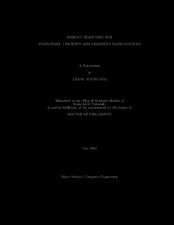Robotic Searching for Stationary, Unknown and Transient Radio Sources
Abstract
Searching for objects in physical space is one of the most important tasks for humans. Mobile sensor networks can be great tools for the task. Transient targets refer to a class of objects which are not identifiable unless momentary sensing and signaling conditions are satisfied. The transient property is often introduced by target attributes, privacy concerns, environment constraints, and sensing limitations. Transient target localization problems are challenging because the transient property is often coupled with factors such as sensing range limits, various coverage functions, constrained mobility, signal correspondence, limited number of searchers, and a vast searching region.
To tackle these challenge tasks, we gradually increase complexity of the transient target localization problem such as Single Robot Single Target (SRST), Multiple Robots Single Target (MRST), Single Robot Multiple Targets (SRMT) and Multiple Robots Multiple Targets (MRMT). We propose the expected searching time (EST) as a primary metric to assess the searching ability of a single robot and the spatiotemporal probability occupancy grid (SPOG) method that captures transient characteristics of multiple targets and tracks the spatiotemporal posterior probability distribution of the target transmissions. Besides, we introduce a team of multiple robots and develop a sensor fusion model using the signal strength ratio from the paired robots in centralized and decentralized manners. We have implemented and validated the algorithms under a hardware-driven simulation and physical experiments.
Subject
radio localizationunknown sensor network
robot motion planning
Searching time
coverage
intermittent signal source
mobile robots
Citation
Kim, Chang Young (2012). Robotic Searching for Stationary, Unknown and Transient Radio Sources. Doctoral dissertation, Texas A&M University. Available electronically from https : / /hdl .handle .net /1969 .1 /ETD -TAMU -2012 -05 -11014.


